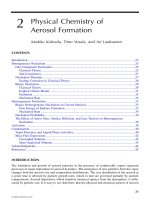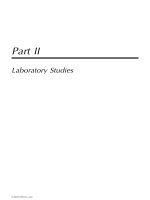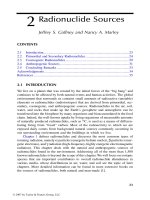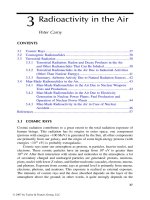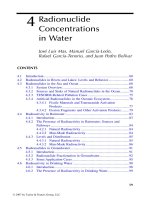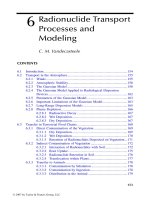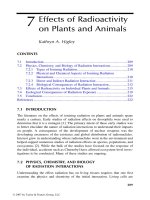Nanotechnology and the Environment - Chapter 2 pptx
Bạn đang xem bản rút gọn của tài liệu. Xem và tải ngay bản đầy đủ của tài liệu tại đây (676.79 KB, 22 trang )
© 2009 by Taylor & Francis Group, LLC
11
2
Nanoscale Materials
Definition and Properties
Kathleen Sellers
ARCADIS U.S., Inc.
This chapter provides a working vocabulary to describe nanoscale materials. It iden-
ti
es a subset of nanoscale materials that are or will potentially be in most “com-
mon” use, and describes those materials as a foundation for understanding their fate
andtransportandpossibletoxicologicaleffects.
This chapter mentions commercially available products containing nanomateri-
alstoillustratevariousaspectsofnanotechnology.Unlessotherwisenoted,product
informationinthischapteroriginatedfromtheNanotechnologyConsumerProducts
InventorymaintainedbytheWoodrowWilsonInstitute[1].
CONTENTS
2.1 Denitions 12
2.2 Classication of Nanosca le Mater ials 13
2.2.1 Origin 13
2.2.2 Composition and Structure 13
2.2.3 Free versus Fixed Nanoparticles 15
2.3 Properties of Nanoscale Materials 16
2.3.1 Overview 16
2.3.1.1 Effect of Increased Surface Area 16
2.3.1.2 Inuence of Quantum Effects 16
2.3.2 Critical Physical and Chemical Properties 17
2.4 Types of Nanomaterials and Applications 23
2.4.1 Titanium Dioxide 25
2.4.2 Zero -Valent I ron 25
2.4.3 Silver 26
2.4.4 Carbon Black 27
2.4.5 Carbon Nanotubes 28
2.4.6 Fullerenes 29
2.5 Summary 30
References 31
© 2009 by Taylor & Francis Group, LLC
12 Nanotechnology and the Environment
2.1 DEFINITIONS
Ananometer(nm)isonebillionthofameter.Thissizescalecanbedifculttograsp
and is perhaps best understood by analogy to common materials. A nanometer is
about100,000timessmallerthaneitherthediameterofahumanhair(Figure2.1)
orthethicknessofasheetofpaper.Aredbloodcellisapproximately5000nmin
size.Anotherwaytograsptherelativescaleofnanoparticlesisthis:thediameterof
afullerene,whichisasphericalnanoparticle1nmindiametercomprising60carbon
atoms, is approximately 10
8
timessmallerthanasoccerball,whichinturnisabout
10
8
smaller than the planet Earth.
ASTM International [2] denes nanotechnology as “a term referring to a wide
range of technologies that measure, manipulate, or incorporate materials and/or
featureswithatleastonedimensionbetweenapproximately1and100nanometers
(nm). Such applications exploit the properties, distinct from bulk/macroscopic sys-
te
ms,ofnanoscalecomponents.”Ananoparticleis“asub-classicationofultrane
particle with lengths in two or three dimensions greater than 0.001 micrometer (1
nanometer) and smaller than about 0.1 micrometer (100 nanometers) and which may
or may not exhibit a size-related intensive property.” The U.S. Environmental Pro-
tection Agency (U.S. EPA) cites a slightly different denition of nanotechnology:
“researchandtechnologydevelopmentattheatomic,molecular,ormacromolecular
levels using a length scale of approximately one to one hundred nanometers in any
dimension;thecreationanduseofstructures,devicesandsystemsthathavenovel
properties and functions because of their small size; and the ability to control or
manipulate matter on an atomic scale.” [3] These denitions suggest three critical
aspectsofnanotechnology:(1)size,(2)functionalityduetothatsize,and(3)inten-
ti
onal manufacture. As the Nanoforum notes [4], “nanotechnology should not be
viewedasasingletechniquethatonlyaffectsspecicareas.Itismoreofa‘catch-all’
termforasciencewhichisbenetingawholearrayofareas,fromtheenvironment,
to healthcare, to hundreds of commercial products.”
FIGURE 2.1 Micrographofananowirecurledintoaloopinfrontofastrandofhumanhair.
(FromMacmillanPublishersLtd.,Tong,L.etal.2003.Subwavelength-diametersilicawires
forlow-lossopticalwaveguiding.Nature, 426 (18 December): 816–819. With permission.)
© 2009 by Taylor & Francis Group, LLC
Nanoscale Materials 13
Thisbookfocusesonasubsetofmaterialsthatareinorhavethepotentialtobe
inthewidestuseatthenanoscale:
Titaniumdioxide:particlesofTiO
2
at the nanometer scale.
Zero-valent iron: particles of Fe
0
.
Silver: particles of Ag.
Carbon black: particulate form of elemental carbon.
Carbon nanotube: hollow tube, commonly made of a single layer of carbon
atoms (single-walled carbon nanotube) or multiple layers (multi-walled car
-
bo
n nanotube). Nanotubes also can incorporate materials other than carbon.
Fullerene: also known as a “buckminsterfullerene” or “buckyball,” a fuller-
en
eisahollowsphere.ThetermcommonlyreferstoC60fullerenescom-
pr
ising60carbonatoms.Otherfullerenestructures,suchasC70andC120,
exist.
In
formationaboutthissubsetofnanomaterialswillprovidethereaderwithan
overview of the range of manufacturing processes, physical characteristics, and toxi-
co
logical effects of nanoscale materials. Table 2.1 summarizes information about
thestructureandcompositionofthespeciednanomaterialsandindicatessome
of their uses. The focus on these materials continues through subsequent chapters
of this book on the manufacture of nanomaterials, fate and transport, and potential
toxicological effects.
Thesectionsthatfollowprovidemoreinformationabouttheclassication,prop
-
erties, and uses of common nanomaterials.
2.2 CLASSIFICATION OF NANOSCALE MATERIALS
Classication schemes used to describe nanomaterials continue to evolve, but gener-
allyrecognizetheoriginofthematerial,whetheritisxedinastructureorfree,its
shape, and/or its composition.
2.2.1 ORIGIN
Some nanoscale materials occur naturally. Examples include volcanic ash and
viruses. Human activities can generate nanoscale materials as incidental byprod-
ucts. Diesel exhaust particles and byproducts of welding, for example, can be in the
nanoscale range [3, 5]. This book focuses on intentionally manufactured nanoscale
materials, however, and not on these naturally occurring or incidental materials.
2.2.2 COMPOSITION AND STRUCTURE
Nanoscale materials can be made of elemental carbon, carbon-based compounds,
metalsormetaloxides,orceramics.Theycantakemanyshapes.Thesegenerally
include the following structures:
Particles or crystals
Tubes, wires, or rods
•
•
•
•
•
•
•
•
© 2009 by Taylor & Francis Group, LLC
14 Nanotechnology and the Environment
TABLE 2.1
Types and Uses of Nanoparticles
Composition
Carbon Metals Ceramic/Silica
Structure
Nano-
particle
Examples
of Uses
Nano-
particle
Examples
of Uses
Nano-
particle
Examples
of Uses
Particle Carbon
black
Pigment;
reinforce-
ment of
rubber
products
Titanium
dioxide
(TiO
2
)
Cosmetics;
environ-
mental
remediation
Ceramic
nano-
particles
Coating
on photo
paper
Nano-sized
wax
particles
Car wax Zero-valent
iron; nano-
magnetite
(Fe
3
O
4
)
Environ-
mental
remediation
Silver Antibacterial
agent in
wound care,
athletic
clothing,
washing
machines
Zinc oxide Cosmetics
Cerium oxide Diesel additive
to decrease
emissions
Tube/wire Carbon
nanotubes
Electronics;
sporting
goods
Nanowire
Dendrimer G5
dendrimer
Targeted
drug
delivery
Iron sulde
clusters
immobilized
in
dendrimers
Environ-
mental
remediation
Other Fullerene Cosmetics Quantum dots Semi-
conductors
Function-
alized
ceramic
nano-
porous
sorbents
Water
treatment
© 2009 by Taylor & Francis Group, LLC
Nanoscale Materials 15
Dendrimers (branched structures)
Composites
Ot
her (e.g., spherical)
Some authorities further subdivide these general structural categories. For
example,theNationalInstituteforOccupationalSafetyandHealth(NIOSH)denes
11 categories of nanomaterial structure [6]:
1. Agglomerated spheres
2. Colloids
3. Crystalline
4. Films
5. Nanohorns
6. Nanorods
7. Nanotubes
8. Nanowires
9. Quantum dots
10. Spherical
11. Other
Others classify nanoparticles by dimension [7–9]. According to this classication
scheme, one-dimensional structures include nano lms, two-dimensional nanomate
-
ri
als include nanotubes, and three-dimensional shapes include fullerenes.
2.2.3 FREE VERSUS FIXED NANOPARTICLES
Freenanoparticles,asthenameimplies,areinsolutionorsuspension.Asaresult,
exposure can occur during manufacture, use, and after disposal. Commercial prod-
uct
s containing free nanoparticles include:
Diesel fuel containing cerium oxide to reduce emissions
Certain sunscreens containing titanium dioxide and a face cream contain
-
in
gfullerenes
Drugs containing dendrimers for targeted delivery
Certain food products, for example vegetable oils, containing nanodrops of
components such as vitamins, minerals, and phytochemicals
Free nanoparticles are likely to be released into the environment through a vari
-
et
yofpathwaysasmaterialsareusedanddisposed.
Alternatively,manufacturingprocessesmayxnanoscaleparticlesintoasolid,
as in the following examples:
Composite tennis rackets strengthened with carbon nanotubes
Rubber products reinforced with carbon black
Computer chips containing nanoscale transistors
•
•
•
•
•
•
•
•
•
•
© 2009 by Taylor & Francis Group, LLC
16 Nanotechnology and the Environment
Once in use, these commercial products containing xed nanoparticles are
unlikely to release nanomaterials to the environment. Therefore, the potential for
humanorecologicalexposuretoxednanoparticlesislimitedaftertheirincorpora-
ti
on into the nal manufactured materials.
2.3 PROPERTIES OF NANOSCALE MATERIALS
2.3.1 O
VERVIEW
The properties of nanoscale materials generally differ from those of the same mate-
rialsinbulksize.Thiseffectresultsfromtwoaspectsofthesmallsizeofnanopar-
ti
cles:(1)theincreasedrelativesurfaceareaperunitmass,and(2)theinuenceof
quantumeffects.Eachofthesepointsisdiscussedbelow.
2.3.1.1 Effect of Increased Surface Area
Reducingthesizeofaparticleincreasestheratioofsurfaceareatomass.Because
the reactive portion of the particle is at its surface, increasing the relative surface
area will increase reactivity for a given amount of material. To illustrate, consider a
spherical particle 0.1 millimeter (mm) in diameter. Its surface area is 3 × 10
−8
m
2
.If
technicians mill the same mass of material into 100-nm-sized spheres, then the total
surface area increases to 3 × 10
−5
m
2
.Decreasingthediameteroftheparticlebya
factor of 1000 increases the surface area by a factor of 1000. If reactive sites cover
thesurfaceoftheparticle,then—allelsebeingequal—thisdecreaseinparticle
sizewouldincreasereactivitysubstantially.Thiseffectaccountsfortheincreased
efciencyofnanoscalecatalystscomparedtotheirbulkcounterparts.
2.3.1.2 Influence of Quantum Effects
At the nanoscale, both classical physics and quantum physics can govern the behav
-
io
rofaparticle.Theinuenceofquantumeffectscanchangeessentialmaterial
characteristics such as optical, magnetic, and electrical properties. An in-depth
explanationoftherelevantphysicsisbeyondthescopeofthisbook,whichfocuses
on the implications of nanotechnology for the environment. In lieu of pages of theo
-
re
ticalexplanationandequations,considerthefollowingexamples.
Inoureveryday,visibleworld,objectsmoveaccordingtoNewton’smodelsof
velocity, acceleration, inertia, and momentum. For example, one can predict the tra
-
je
ctoryofalacrosseballbasedonitsmassandvelocity,thepullofgravity,andthe
resistanceoftheair.Ifthelacrosseballsplashesintoapond,itsnaltrajectoryalso
willreectthebuoyancyofthewater.
Otherfactors,however,caninuencethemovementofamoleculeorcertain
nanoparticles. Even nonpolar molecules exhibit slight, transient polarity of charge
because of instantaneous shifts in electron density. (Quantum mechanics projects
thiselectrondensityprobabilistically.)Aslightnegativechargeonaportionofa
moleculeornanoparticleduetothistransientpolaritywillbeattractedtoapositive
charge or repelled by a negative charge. These weak and transient intermolecular
forces are called Van der Waals forces. For many nanoparticles — unlike the lacrosse
© 2009 by Taylor & Francis Group, LLC
Nanoscale Materials 17
ball — these slight, transient forces can inuence the movement of a particle through
liquid.VanderWaalsforcescancausenanoparticlestoagglomerate,oradsorbto
each other via physisorption (physical adsorption). (For further information on the
fate and transport of nanoscale materials, see Chapter 6.)
Just as Newton’s laws predict the movement of a large solid, Ohm’s Law relates
current,voltage,andresistancetomodelthebulkowofelectronsthroughametal
-
li
cwire.Solidcarbonintheformofthegraphiteusedinpencilleaddoesnotconduct
electricity well. This property can change when a sheet of graphite one atom thick is
wrapped to form a single-walled carbon nanotube. Some carbon nanotube structures
canfunctionassemiconductors.Otherscanconductelectricityasifthematerial
weremetal,althoughvirtuallywithoutresistanceasaresultofthecoordinatedtrans
-
fe
r of electrons between atoms straight down the length of the nanotube. The ow
ofelectricityreectsindividualpacketsofenergyassociatedwiththemovementof
individualelectrons,ratherthanthebulkowofelectronsmodeledbyOhm’sLaw.
Thenextexampleoftheuniquepropertiesassociatedwithnanoparticlesis,iron
-
ica
lly, centuries old. Medieval glass blowers used nanoscale particles of gold to color
stained-glass windows. The optical properties of gold change at nanoscale. As metal
particles become smaller, the quanta (or discrete packets) of light energy that can
interactwiththemincrease.Dependingontheirsize,nanoscalegoldparticlescan
bepurple,green,orange,orred[10].Similarly,zincoxide—notoriousforcoating
lifeguards’noseswhiteagenerationago—becomestransparentatthenanoscale.
Theseexamplesillustratesomeofthewaysinwhichthesmallsizeofsome
nanoparticlescanaffecttheirbehaviorandproperties.Itisthesechangesinproperties
relative to those of the corresponding bulk materials that account for many of the
usesandmuchoftheexcitementsurroundingnanotechnology.
2.3.2 CRITICAL PHYSICAL AND CHEMICAL PROPERTIES
Itisclearthatnanoscalematerialsdonotnecessarilybehaveinwayspredictedfrom
thebehavioroftheirtraditionallyscaledcounterparts.Asaresult,thephysicaland
chemical properties that scientists usually use to predict environmental fate and
transport and the consequences of exposure do not sufce to characterize nanoscale
materials. Table 2.2 lists properties that may be relevant to nanotechnology and the
environment according to three paradigms:
1.
U.S. EPA’s voluntary Nanoscale Materials Stewardship Program (NMSP)
under the Toxic Substances Control Act (TSCA) [11]. As
described further
inChapter4,theU.S.EPAhasproposedthisprogramtogatherinformation
aboutnanomaterialstoprovideabasisfordevelopingregulations.
2.
The Voluntary Reporting Scheme for engineered nanoscale materials
developed by the Department for Environment, Food and Rural Affairs
(Defra) in Great Britain [13]. De
fraestablishedthisprogramtocollect
information needed to assess the extent to which current regulations and
controls sufce to control the potential risks from nanomaterials.
3. The Nano-Risk Framework, which the Environmental Defense–DuPont
Nano Partnership developed to evaluate the potential risks of nanoscale
© 2009 by Taylor & Francis Group, LLC
18 Nanotechnology and the Environment
TABLE 2.2
Critical Properties of Nanomaterials
Paradigm
Property
Nanoscale
Materials
Stewardship
Program
[11]
Voluntary
Reporting
Scheme
[12]
Life Cycle
Analysis:
NanoRisk
Framework
a
[13]
1. Nomenclature:
Technical name • • •
CAS Registry Number • • •
Commercial name/trade name • • •
Common name • • •
2. Physical/chemical properties:
A. General characteristics:
Chemical composition, including surface coating • • •
Molecular structure • •
b
•
Crystal structure • •
Physical state/form at room temperature and
pressure
•••
B. Purity of commercial product:
Purity (or impurities in commercial product) • • •
Byproducts resulting from the manufacture,
processing, use, or disposal of the chemical
substance
••
Stabilizing agent, inhibitor, or other additives •
C. General properties:
pH (at specied concentration) •
Solubility in water • • •
Vapor pressure • • •
Henry’s Law coefcient •
Melting temperature • •
Boiling/sublimation temperature • • •
Flash point •
Self-ignition temperature •
Dispersability •
Bulk density • • •
Dissociation constant •
Surface tension •
Any unique or enhanced properties that arise from
the nanoscale features of the material
•
© 2009 by Taylor & Francis Group, LLC
Nanoscale Materials 19
TABLE 2.2 (CONTINUED)
Critical Properties of Nanomaterials
Paradigm
Property
Nanoscale
Materials
Stewardship
Program
[11]
Voluntary
Reporting
Scheme
[12]
Life Cycle
Analysis:
NanoRisk
Framework
a
[13]
D. Particle characteristics:
Particle size and size distribution (granulometry) • • •
Aspect ratio •
Average aerodynamic diameter •
Average particle mass • •
Particle shape • • •
Particle density • •
Agglomeration state • • •
Deglomeration and disaggregation properties •
E. Surface characteristics:
Surface area • • •
Average particle surface area •
Surface charge/zeta potential • •
Porosity • •
Surface chemical composition • •
Surface reactivity •
Surface area/volume ratio •
3. Production process:
Production type (batch/continuous) and rate • •
Brief description of manufacturing process •
Source of the material, where the material is not
produced by the notier
•
Intended uses of the material and benets of the uses •
Detailed description of production process, including
unit operations, chemical conversions, and mass
balance (including potential releases to the
environment)
••
Potential worker exposure • • •
Personal protective equipment/engineering controls • •
Environmental release and disposal • • •
4. Methods for characterization:
Spectra • •
Chromatographic data (high-pressure liquid
chromatography, gas chromatography)
•
© 2009 by Taylor & Francis Group, LLC
20 Nanotechnology and the Environment
TABLE 2.2 (CONTINUED)
Critical Properties of Nanomaterials
Paradigm
Property
Nanoscale
Materials
Stewardship
Program
[11]
Voluntary
Reporting
Scheme
[12]
Life Cycle
Analysis:
NanoRisk
Framework
a
[13]
Methods of detection and determination for the
substance and its transformation products after
discharge into the environment
•
5. Environmental fate and transport
c
:
Diffusion rate •
Gravitational settling rate • •
Sorption rate • •
Deposition rate • •
Wet and dry transport • •
Adsorption-desorption coefcients • •
d
•
Octanol-water partition coefcient • •
Volatilization from water •
Volatilization
from soil •
Distribution among environmental media •
Nanomaterial aggregation or disaggregation in
exposure medium of concern
•
Biodegradability (organic nanomaterials only) • • •
Bioaccumulation potential • • •
Biotransformation •
Photodegradability • •
Stability in water (hydrolysis) •
Inuence of redox reactions • • •
Abiotic degradation •
6. Safety hazards:
Flammability • • •
Explosivity • • •
Incompatability •
Reactivity •
Corrosivity •
7. Human health hazards:
Any hazard warning statement, label, material safety
data sheet, or other information which will be
provided to any person who is reasonably likely to be
exposed to this substance
••
© 2009 by Taylor & Francis Group, LLC
Nanoscale Materials 21
TABLE 2.2 (CONTINUED)
Critical Properties of Nanomaterials
Paradigm
Property
Nanoscale
Materials
Stewardship
Program
[11]
Voluntary
Reporting
Scheme
[12]
Life Cycle
Analysis:
NanoRisk
Framework
a
[13]
Acute toxicity:
Administered orally •
Administered by inhalation •
Administered cutaneously •
Eye irritation •
Repeated dose toxicity (28 days) •
Short-term toxicity, including one or more of the
following:
•
• 28-day inhalation study with full histopathology,
over 90-day observation period
• Single-dose instillation study with full
histopathology, over a 90-day observation period
• 28-day repeated-dose oral toxicity test with full
histopathology, over a 90-day observation period
Skin sensitization/irritation • •
Skin
penetration, if valid tests exist •
Genetic toxicity tests • •
Assessment of the toxicokinetic behavior derived
from base set data and other relevant information
•
Toxicity assessment derived from non-animal test
methods, including in vitro methods
and Quantitative
Structure Activity Relationships (QSARs)
•
8. Environmental hazards:
Bacteriological inhibition •
Acute aquatic toxicity to: • •
• Fish (fathead minnow or rainbow trout)
• Invertebrates (daphnia) — acute or chronic
depending on conditions
• Aquatic plants (algae)
Terrestrial toxicity, including acute toxicity to: •
• Invertebrates (earthworms)
• Plants
9. Risk management practices:
Possibility of recycling •
Possibility of neutralization of unfavorable effects •
© 2009 by Taylor & Francis Group, LLC
22 Nanotechnology and the Environment
materials [13]. Chapter 11 discusses this paradigm for Life Cycle Analysis
in more detail.
Other specialized paradigms, for example, the Assay Cascade Protocol that the
National Cancer Institute uses to characterize the compatibility of nanomaterials
with biological systems [14], may stipulate other critical parameters. Perhaps not
surprisingly,notallthedatalistedinTable2.2arereadilyavailableyetforthenano
-
m
at
erials currently in industrial and commercial use.
The critical properties of nanomaterials, as listed in Table 2.2, include many
“conventional” parameters that scientists use to characterize bulk chemicals. Such
properties include solubility, vapor pressure, boiling point, and other phase proper
-
ti
es; reactivity and degradability; and toxicity based on various bioassays. The critical
properties also include some of particular importance to nanomaterials, as follows.
Particle size. The small size of nanoparticles increases the surface area per
unitvolumerelativetoamaterial’sbulkcounterpart.Thesmallsizealso
affects the particles’ fate and transport in the environment. Nanoparticles
can generally remain suspended in air or water because their small size
limits gravitational settling. As particles agglomerate and the net particle
size increases, they can drop out of suspension. Particle size also affects a
particle’sabilitytopenetrateintobodilyorgans.
Particle shape. The
shape of a nanoparticle affects its ability to agglomer-
ateandreact,andtopenetrateintobodilyorgans.“Sterichindrance”occurs
whentheshapeofaparticleormoleculephysicallypreventsareactionfrom
occurring.
Particle surface area. In
creased relative surface area (as a result of the
small particle size) increases the reactivity of nanomaterials compared to
theirbulkcounterpartsandaffectsotherproperties.
•
•
•
TABLE 2.2 (CONTINUED)
Critical Properties of Nanomaterials
Paradigm
Property
Nanoscale
Materials
Stewardship
Program
[11]
Voluntary
Reporting
Scheme
[12]
Life Cycle
Analysis:
NanoRisk
Framework
a
[13]
Possibility of destruction •
Others •
10. Existence of non-disclosed data •
a
Base set data; additional data may be needed.
b
Description and measurement of the structure of the nanoscale material, including details of the
measurement technique used.
c
In addition to physical/chemical properties.
d
Absorption/desorption screening test.
© 2009 by Taylor & Francis Group, LLC
Nanoscale Materials 23
Explosivity, ash point, and self-ignition temperature. The high surface
area of very small particles increases their tendency to combust when
suspendedinairinthepresenceofanignitionsourcesuchasstaticcharge
or sparks. Readers may be familiar with this phenomenon from reports of
dustexplosionsingrainelevators.Thepotentialforcombustioncanbea
safety issue for some nanomaterials.
Degree of agglomeration*.
VanderWaalsforces,whichareweak,transient
intermolecularforcesresultingfromtransientpolarityrelatedtoshiftsin
electron density, can cause nanoparticles to agglomerate. Agglomeration
increases the net particle size, thereby changing the size-dependent charac
-
t
e
ristics and behavior of the original nanomaterial. The Hamaker constant
represents the net van der Waals attraction.
Surface charge. T
h
is affects dissolution, suspension in water, and sorption,
andisoftenrepresentedbythezetapotential.Apositivechargeonthe
surfaceofacolloid(suchasametaloxidenanoparticle)inwaterattracts
negativelychargedionsintheuid.Thesenegativelychargedionsform
theso-called“Sternlayer”aroundthecolloid.Thezetapotentialisthe
chargemeasuredattheoutermostportionoftheSternlayer.Asdiscussed
furtherinChapter6,thestabilityofananoparticlesuspensionrelatestoits
zeta potential. The electrostatic repulsion resulting from surface charge can
counter the tendency toward agglomeration.
These properties affect the fate and transport of nanomaterials in the environment, their
toxicity, and their fate in wastewater treatment, as discussed in subsequent chapters.
2.4 TYPES OF NANOMATERIALS AND APPLICATIONS
New applications of nanotechnology appear constantly. The Nanotechnology Con-
sumerProductsInventorymaintainedbytheWoodrowWilsonInstitutelistedover
500consumerproductscontainingnanomaterialsasofJune2007[1].Theinventory
grewfrom212to502productsbetweenMarch2006andJune2007,demonstrating
the explosive growth of this market. Those products represent an extraordinarily
wide range of applications. The list of products below demonstrates the range by
example. (Characterizations of nanoscale ingredients in the materials on this list,
andtheireffects,weremadebythemanufacturersascitedbytheNanotechnology
Consumer Products Inventory. The information provided below is not intended as an
endorsement,butsimplytoillustratetherangeofproductsandapplications.)
Cosmetics and personal care products:
RevitaLift® Intense L
ift Treatment Mask (L’Oreal®) — uses nanosomes,
tiny capsule-like structures, to transport active ingredients into the
skin'souterlayerandthenreleasethem.
* ASTM International distinguishes between agglomeration and aggregation of nanoparticles as fol-
lows [2]. An agglomerate is a group of particles held together by relatively weak forces (such as Van
derWaalsforces)thatcanbebrokenapart.Anaggregateisadiscretegroupofparticlescomposedof
individual components that are tightly bonded together and not easily broken apart.
•
•
•
•
•
© 2009 by Taylor & Francis Group, LLC
24 Nanotechnology and the Environment
SergeLutensBlusher(BarneysNewYork®)—“NanoDispersiontech-
nology”createsanepowder.
Chemical-Free [sic] Sunscreen SPF 15 (Burts Bees®,I
nc.) — contains
nano-sizedparticlesoftitaniumdioxideastheactiveingredient.
Food supplements and food storage:
MesoZinc™ (Purest C
olloids, Inc.) — nutritional supplement containing
30 parts per million (ppm) zinc nanoparticles.
FresherLonger™ Miracle F
ood Storage (Sharper Image®)—foodstor-
agecontainersareinfusedwithsilvernanoparticlesasanantibacterial
agent.
Si
lver Nano Baby Milk Bottle (Baby Dream® Co., L
td.) — “silver nano
polysystem”actsasanantibacterialanddeodorizer.
Appliances:
Samsung® Washing M
achine (Samsung®) — Silver Nano technology
“sterilizesyourclothes.”
Daewoo® Vacuum C
leaner (Daewoo®)—nano-silvercoatedcyclone
canister removes bacteria.
Samsung® Air C
onditioner—containssilvernanolterandsilvernano
evaporator.
Clothing:
Sp
ortAnkletSock(AgActive)—treatedwithnanoparticlesofsilver
(typically 25 nm) as bactericide and fungicide.
NANO-PEL™ clothing (
Nordstrom® Inc.) — fabric used in clothing such
as pants is treated with Nano-Tex process to bind water-repellent mol-
ec
ules to cotton bers, in order to impart stain resistance.
Coatings:
Pi
lkington Activ™ Self Cleaning Glass (Pilkington plc) — glass coating
that works with ultraviolet (UV) light and rain to keep glass free from
organic dirt.
Turtle Wax® F21™
CarWash(TurtleWax®,Inc.)—nanotechnologyformula
comprising synthetic polymers provides protection against UV light.
Behr® PREMIUM P
LUS® Exterior Paint (Behr® Process Corporation) —
proprietary nanoparticles improve adhesion and anti-mildew properties.
Ultima® Photo P
aper (Eastman Kodak® Company) — nine-layer com-
position incorporates ceramic nanoparticles to resist the effects of heat,
humidity,light,andozone.
Electronics and computers:
Invisicon™ (Eikos®)—
Invisicon™ ink used to create transparent conduc-
tivecoatingsandmanufactureprintedcircuitsontransparentplastic
lms; Invisicon™
incorporates ca
rbon nanotubes with a 1000:1 aspect
ratio. Applications include at panel displays.
XBOX 360® (Microsoft®)—
microprocessor chip manufactured by
IBMusingIBM’s90nanometerSilicononInsulator(SOI)technology
to reduce heat and improve performance.
•
•
•
•
•
•
•
•
•
•
•
•
•
•
•
•
•
•
•
•
•
© 2009 by Taylor & Francis Group, LLC
Nanoscale Materials 25
Sporting goods:
Wilson® TourDavisCupOfcialTennisBall(Wilson®) — incorporates
“NanoPlay” technology to increase durability.
Head® Nano Titanium Tennis Racquet (Head®)—integratesnanoscale
materials.
Wilson® [K]Factor®
Tennis Racket (Wilson®) — contains Karophite
Black, created by bonding carbon black, graphite, and silicon dioxide
together at the nano level.
Some of these product descriptions illustrate how manufacturers can guard the
details of proprietary technology by providing little information about the nanoma-
te
rials in their products. Many of these consumer products do, however, contain one
ormoreofthenanomaterialsthatarethefocusofthisbook.Thesectionsbelowpro-
videinformationontitaniumdioxide,zero-valentiron,silver,carbonblack,carbon
nanotubes, and fullerenes.
2.4.1 TITANIUM DIOXIDE
Titaniumisacommonelement,foundinthemineralsrutile(predominantlytitanium
dioxide, TiO
2,
also known as titania) and ilmenite (FeTiO
3
). Manufacturers have long
used TiO
2
asapigment,andinweldingelectrodes,ceramics,andcatalysts.Asthe
primary white pigment, it is used to color paint, plastics, paper, and inks. The func-
tionsofTiO
2
depend on its ability to absorb or reect light of different wavelengths.
TiO
2
acts as a pigment because the particles can scatter visible light, a function
that depends on particle size. TiO
2
also can absorb UV radiation. As a result, coat-
ings containing TiO
2
can provide protection from photochemical degradation. Upon
absorption of UV light, TiO
2
cangeneratehydroxylradicals.TheTiO
2
pigment then
actsasaphotocatalyst[15]forthedecompositionoforganiccompounds.Thecrys-
talline structure of nanoscale TiO
2
particles allows those particles to absorb visible
lightaswellasUVlight,whichbroadenstheapplicationsforTiO
2
catalysts [16].
Commercially available products that exploit these properties of nanoscale TiO
2
include [1]:
SunscreensbymorethanadozenmanufacturersrelyontheabilityofTiO
2
to absorb UV radiation to protect the skin.
T-2® Photocatalyst Environment Cleaner (T-2®)—whenlightstrikesnano-
scale TiO
2
in this cleaner after it is applied to a surface, photocatalytic reac-
tionsdegrade“organictoxins,odors,andmore.”
Carrier® Pure D
ew Filtration (Carrier®)—thisairpuriercontainsaNano
Silver lter, for antibacterial action, and a Nano Photocatalytic lter. The
latter contains nano-sized particles of TiO
2
to“getridofunpleasantsmell
and smoke.”
2.4.2 ZERO-VALENT IRON
Engineers use nanoparticles of elemental iron known as nano zero-valent iron (nZVI),
as discussed further in Chapter 10, to treat groundwater containing chlorinated
•
•
•
•
•
•
•
© 2009 by Taylor & Francis Group, LLC
26 Nanotechnology and the Environment
solvents, arsenic, and other contaminants in situ.GranularZVIhasbeenusedsince
the mid-1990s in groundwater remediation. Practitioners realized early in the use of
granularZVIthattherateofreductivedechlorinationofchlorinatedhydrocarbons
depended strongly on the surface area of the ZVI particles. This realization led to the
development of nZVI. Particles of nZVI generally range between 40 and 300 nm in
diameter. This particle size, because of the increased surface area, provides greater
reactivitythanthegranularZVIinitiallyinuse.ThedirectinjectionofnZVI,how
-
e
v
er,canbelimitedintheeldbythetendencyofthenanoparticlestoagglomerate,
andasdiscussedinChapter10,alternativemethodstoalleviatethistendencyare
being developed.
2.4.3 SILVER
Some95%ofsilverisusedinphotography,jewelryandsilverware,andinvarious
industrial applications. The latter includes electrical components, brazing alloys and
solders, bearings, catalysts, miniature batteries, photovoltaic cells, and other prod
-
uct
s[17,18].
Silverhaslongbeenrecognizedasanantibacterialagent.CyrustheGreat,King
ofPersia,reportedlykeptwaterfreshinthesixthcenturyB.C.byboilingthewater
andthenstoringitinsilveragons[19].PlinytheElder,writingin78A.D.,saidthat
silver slag “… has healing properties as an ingredient in plasters, being extremely
effectiveincausingwoundstocloseup.”Inmoderntime,silverhasbeenusedto
purify drinking water, sanitize swimming pools, and prevent sepsis in wounds [17,
18]. Silver’s antibacterial function results from its ability to disturb the multiplication
function of bacteria [17].
Thousandsofyearsaftertherstapparentuseofsilverasabactericide,nanoscale
particlesofsilverlendantibacterialqualitiestonewcommercialproducts.Approxi
-
mat
ely 20% of the available nanotechnology consumer products are those containing
nano-scale silver. Most incorporate silver due to its antibacterial properties. These
pr
oducts include, as described above, clothing, food storage containers, and appli
-
an
ces. They also include wound care products [1].
Nano-scalesilvermayndmoreusesinthefuture.Inonetypeofapplication,
nano-scale silver is used in an extraordinary analytical technique. Two types of
nanoprobes have been developed under the sponsorship of the U.S. Department of
Energy[20,21].Eachprobeconsistsofasilicaopticalberbetween20and100nm
in diameter coated with a thin layer of silver. The “nanobiosensor” probe allows
scientiststophysicallyprobeinsidealivingcellwithoutdestroyingit.Inoneappli
-
cati
on,abioreceptormolecule,suchasanantibody,DNA,orenzymethatwillbind
to a specic target molecule of interest inside the cell, is immobilized on the sil
-
ve
r surface at the nanoprobe tip. Only the target molecules that become bound to
the bioreceptor are exposed to and excited by an evanescent laser signal, giving off
detectable uorescent light. The team leader, Tuan Vo-Dinh, has stated that:
“[T}he nanobiosensor has important implications ranging from drug therapy to national
security, environmental protection, and a better understanding of molecular biology at
asystemslevel.Thisareaofresearchistrulyatthenexusofnanotechnology,biology,
and information technology.”
© 2009 by Taylor & Francis Group, LLC
Nanoscale Materials 27
A variation on the nanoprobe is based on the light-scattering technique known as
surface-enhancedRamanspectroscopy(SERS).Thisprobecandetectandanalyze
chemicals, including explosives and drugs on surfaces, at a theoretical single-mol-
ec
ulelevel.Thiscapabilitymakesthenanoprobefarmoreselective,sensitive,and
accurate than conventional analytical techniques. The SERS nanoprobe is being
developed for nanotechnology applications from military and water monitoring
applications to medical environments.
2.4.4 CARBON BLACK
Carbon black comprises ne particles of elemental carbon. It is arguably one of the
oldest nanomaterials in commercial use and certainly the most widely used. The
Chinesemanufacturedanimpureformofcarbonblackmorethan3500yearsagoby
burning vegetable oils in lamps. Modern manufacturers still produce carbon black
from the incomplete combustion or thermal decomposition of hydrocarbons (usually
heavy aromatic oils). Worldwide, manufacturers produced approximately 18 billion
poundsofcarbonblackin2004.About90%ofthisoutputfounduseinrubberprod
-
ucts,whereitservesasallerandastrengtheningorreinforcingagent.Carbonblack
alsoisusedinplastics,coatings,andinks[22,23].
Carbonblackconsistsofmorethan97%elementalcarbon.Carbonblackpar
-
t
i
cles, or nodules, comprise stacks of graphite-like sheets of carbon. Carbon black
products are characterized by their structure, size, surface area, surface activity, and
particle size [22].
Carbon black particles generally range in size from tens to a few hundred nano
-
me
ters.Asaresult,manyclassifycarbonblackasananomaterial(e.g.,[3,22,24]).
The International Carbon Black Association, however, holds a different view [23];
itholdsthatwhiletheinitialparticlesizemaybeonthenanoscale,vanderWaals
forces cause these particles to rapidly aggregate into “basic indivisible entities” of
carbonblackapproximately85to500nminsize.Theseaggregatesthenadhereto
formstableagglomeratesontheorderof1toover100μminsize.Manufacturers
shapetheseaggregatesintocarbonblackpelletsbetween0.1and1.0mminsize
before shipment to their customers. The International Carbon Black Association
indicates that nanoparticles of carbon black “are not found outside the reactor, nor
are they found as a component dust fraction in nal manufactured carbon blacks.”
These differences in the categorization of carbon black illustrate two important
points regarding nanotechnology:
1. Strong attractive forces can cause individual particles to agglomerate read
-
il
y, changing their characteristics and limiting their transport in the envi-
ro
nment. (See Chapter 6 for further discussion of the forces that govern the
behavior of nanoparticles.)
2. Literature reports on nanotechnology warrant careful reading to ascer
-
t
a
intheactualparticlesizeandformunderdiscussion,andtodetermine
whether experimental conditions correspond accurately to the form of a
material that is actually commercially available or used. (Chapter 8 dis-
cu
sses some of the techniques used to suspend nanoparticles in solution for
© 2009 by Taylor & Francis Group, LLC
28 Nanotechnology and the Environment
toxicity testing, and how those techniques should affect the interpretation
of the results.)
2.4.5 CARBON NANOTUBES
Thepropertiesofnanotubessoundlikesciencection;thesetinycylinderscan
have extraordinary strength and unusual electrical properties. Their characteristics
dependontheircomposition,size,andorientation,asdescribedbelow[25–27].
This discussion focuses on carbon nanotubes (CNTs) rather than metal-based
nanotubes. CNTs consist of one or more thin sheets of graphite one atom thick,
knownasgraphene,whicharerolledtocreateahollowcylinder(Figure2.2).A
single-walledcarbonnanotube(SWNT)containsonelayerofgraphene;amulti-
walled carbon nanotube (MWCNT) comprises concentric
cylinders of graphene.
SWNT diameters generally range from 0.4 to 2.5 nm; MWCNT, up to several hun
-
dr
ed nanometers.
Ingraphene,eachcarbonatombondstothreeothercarbonatoms.Theresult
-
in
g hexagonal lattice resembles a honeycomb. Depending on the orientation of the
hexagons—thatis,onthechiralityofthegraphenesheet—anSWNTcantakeon
different congurations. These different congurations affect the electrical proper
-
tiesofananotube.
In general, CNTs have the following properties:
Insolubleinwaterand,formostformsofcarbonnanotubes,insolublein
solvents.
Gr
eat physical strength and exibility. Carbon nanotubes have a Young’s
modulusofapproximately1terapascal(TPa)andtensilestrengthupto150
GPa. By these measures, carbon nanotubes are approximately 200 times as
strong as steel.
Light weight (density 2.6 g/cm
3
,aboutone-thirdthedensityofsteel).
Depending on the structure, CNTs are conductors or semiconductors. A
nanotubewiththecarbonatomsarrangedinstraightlinesalongthelength
of the tube conducts electricity very efciently. When the carbon atoms are
arrangedinaspiral,thenanotubeisasemiconductor.
High thermal conductivity.
High storage capacity for chemical substances within the hollow cylinder.
•
•
•
•
•
•
FIGURE 2.2 Illustrationofacarbonnanotube.(FromChrisEwels,www.ewels.info.
With permission.)
© 2009 by Taylor & Francis Group, LLC
Nanoscale Materials 29
ScientistscanalterthepropertiesofCNTsbyaddingfunctionalgroupstothe
outsideofthenanotubes.Forexample,addinghydroxylgroupstotheoutersurface
canmakeCNTswatersoluble.
ThephysicalpropertiesofCNTsmayleadtoawidevarietyofcommercialappli
-
cati
ons. CNTs may ultimately have the following uses [27]:
Materials and chemistry applications: polymer CNT composites, coatings,
membranes, and catalysis
Medicine and life science tools: “lab on a chip” for medical diagnoses, drug
delivery,chemicalsensors,andltersforwaterandfoodtreatment
Electronics and information technology: lighting elements, single-electron
transistors,molecularcomputinganddatastorage,electromechanicalsen
-
so
rs, micro-electro-mechanical systems (MEMS)
Energy: super capacitors for energy storage, solar cells, fuel cells, and
superconductive material
Products containing CNTs that are now available [1] include a variety of sport
-
in
g goods that utilize nanotubes to strengthen the resins. These include baseball bats,
bicycle frames, golf clubs, hockey sticks, and tennis rackets. CNTs also have been
used to strengthen plastics used in automobiles. Finally, two products use carbon
nanotubesinvideodisplays.
2.4.6 FULLERENES
Afullereneisasphericalparticlemostcommonlycomprising60carbonatoms
arrangedas20hexagonsor12pentagons(Figure2.3).ThediameterofaC60fuller-
en
eisapproximately10.0Angstroms(Å),or1.00nm.ThestructureofaC60mol-
ec
ule resembles one of the geodetic domes built by architect R. Buckminster Fuller,
and thus the name “buckminsterfullerene,” abbreviated “fullerene.” The discovery
•
•
•
•
FIGURE 2.3 Fullerene.
© 2009 by Taylor & Francis Group, LLC
30 Nanotechnology and the Environment
offullerenesmeritedaNobelPrizeawardtoDr.RichardSmalley,Dr.RobertCurl,
andDr.HaroldKrotoin1996[28].MuchofthisworkoccurredatRiceUniversity
in Texas, leading the legislature of the State of Texas to designate, in 1997, that the
buckminsterfullereneistheofcialStateMoleculeofTexas[29].
TheC60fullereneisthemostcommonform,followedbyC70;higherfullerenes
includeC74,C76,C78,C80,C82,C84,andC86throughC96.Variationsonthe
fullerene structure include [30]:
Endohedral or incarfullerenes. T
he
se fullerenes entrap (or incarcerate)
elements or molecules within the carbon matrix.
Multi-walled or nested fullerenes. The
se particles comprise two or more
nested fullerenes.
Heterofullerenes. In these fullerenes, an atom such as boron, nitrogen, or
phosphorous replaces one or more carbon atoms in the fullerene.
Thepropertiesoffullerenesdependonthestructure,derivatization,anddegree
of agglomeration. In general, pure fullerenes have low solubility in water. Under cer-
ta
inconditions,fullereneswillformpolymorphichexagonalunitcellagglomerates
inwaterreferredtoasnano-C60.Theseagglomerates,approximately25to500nm
in size, carry a strong negative charge. Scientists have detected fullerenes in ancient
geologic formations, suggesting that they can originate from natural sources as well
as manufacturing processes, and that fullerenes can be extraordinarily stable under
geologic conditions [31].
Fullerenes are electron decient and can react with nucleophilc species. They are
notoxidizedreadily,althoughinthepresenceofoxygenandlight,oxidativedegrada
-
ti
onofC60toC
120
Ooccurs.ThelargerfullerenesarelessreactivethanC60[30].
Possible applications for fullerenes include catalysts and sensors; nanocompos-
ites containing fullerenes can be used in optics and photochemistry applications, and
endohedral fullerenes also can be used as medical therapeutic agents [32]. Of the
eight commercial products listed in the Nanotechnology Consumer Products Inven-
to
ry[1]ascontainingcarbonfullerenes,sevenarecosmeticsproductsandoneis
sportsequipment.SomeofthecosmeticproductstouttheabilityofC60fullerenes
to scavenge free radicals.
2.5 SUMMARY
Nanomaterials share the characteristic that they are between 1 and 100 nm in at least
onedimension.Asaresultofthissmallsize,thephysicalandchemicalpropertiesof
nanoparticles can differ from those of the same material in bulk form. The smaller
size means that the relative surface area of the particle is larger and therefore its rela-
ti
ve reactivity increases. For some materials, the ability of an atom or molecule to
absorb or emit energy in quanta begins to inuence the nanomaterial’s behavior.
Beyond those generalizations, however, nanomaterials vary widely in terms of
theircomposition,properties,anduses.Tobringfocustodiscussionsofnanotech-
no
logyandtheenvironment,thisbookfocusesonsixengineerednanomaterials:
•
•
•
© 2009 by Taylor & Francis Group, LLC
Nanoscale Materials 31
1. Titanium dioxide
2. Silver
3. Zero-valent iron
4. Carbon black
5. Carbon nanotubes
6. Fullerenes
REFERENCES
1. WoodrowWilsonInternationalCenterforScholars.ProjectonEmergingNanotechnolo-
gies: A Nanotechnology Consumer Products Inventory. />inventories/consumer/. (Accessed June 27, 2007)
2. ASTM International. 2006. Designation: E 2456 – 06. Standard Terminology Relat
-
in
gtoNanotechnology.
3. U.S. Environmental Protection Agency. 2007. Nanotechnology White Paper. EP
A/100/
B-07/001. Prepared for the U.S. Environmental Protection Agency by members of the
Nanotechnology Workgroup, a group of EPA’s Science Policy Council, 5, 7, 55–60.
4. nanoforum.org, undated. European Nanotechnology Gateway. What is Nanotechnol
-
o
g
y? (Accessed December 9, 2007)
5. Gwinn, M.R. and V. Vallyathan. 2006. Nanoparticles: health effects — pros and cons.
Environ. Health Perspect., 1
14(12):1818–1825.
6. National Institute for Occupational Safety and Health. Nanoparticle Information
Library. (Accessed June 27, 2007)
7. Sweet,L.andB.Strohm.2006.Nanotechnolgy—Life-cycleriskmanagement.
Hum.
Ecolog. Risk Assess., 1
2:528–551.
8.EnvironmentalDefenseandDuPont.2007.NanoRiskFramework.21June.http://
www.NanoRiskFramework.com. (Accessed June 27, 2007), 13.
9. The Royal Academy of Engineering, the Royal Society. 2004. Nanoscience and Nano
-
te
chnologies: Opportunities and Uncertainties, Chapter 3
.29July.al-
soc.ac.uk. (Accessed October 15, 2006)
10. Ratner, M. and D. Ratner. 2003. Nanotechnology: A Gentle Introduction to the Next
Big Idea, 1
2–13, 3
5.UpperSaddleRiver,NJ:PrenticeHallProfessionalTechnical
Reference.
11
. Environmental Protection Agency. 2007. Nanoscale Program Approach for Comment:
Information Collection in Support of EPA’s Stewardship Program for Nanoscale Mate-
ria
ls; Reporting Form. Attachment A: Nanoscale Materials Stewardship Program Data
Form.12July. />12. Department for Environment Food and Rural Affairs, 2006. Voluntary Reporting
Scheme for Engineered Nanoscale Materials — Data Reporting Form. October 2006.
(Accessed
September 7, 2007)
13. Environmental Defense – DuPont Nano Partnership. 2007. Nano Risk Framework. 21
June. . (Accessed June 27, 2007)
14. U.S. National Institutes of Health, National Cancer Institute, Nanotechnology Charac
-
te
rization Laboratory. Assay Cascade Protocols. />cascade.asp.
15
. Fisher, J. and T.A. Egerton. 2001. Titanium Compounds, Inorganic. In Kirk-Othmer
Encyclopedia of Chemical Technology.
NewYork:JohnWiley&Sons,Inc.
16. Li, H., S.G. Sunol, and A.K. Sunol. 2005. Environmentally Friendly Pathways for Syn-
th
esis of Titanium Dioxide Nanoparticles. In Technical Proceedings of the 2005 NSTI
Nanotechnology Conference and Trade Show, 2
:62–26.
© 2009 by Taylor & Francis Group, LLC
32 Nanotechnology and the Environment
17.Etris,A.F.2001.Silverandsilveralloys.InKirk-Othmer Encyclopedia of Chemical
Technology, 4
:761–803.NewYork:JohnWiley&Sons,Inc.
18. The Silver Institute. 2007. Uses. (Accessed
September 9, 2007).
19. Baker, M.N. 1948.
The Quest for Pure Water, 4. N
ew Y
ork: The American Water Works
Association, Inc.
20. Vo-Dinh, T., P. Kasili, and M. Wabuyele. 2006. Nanoprobes and nanobiosensors for
monitoring and imaging individual living cells.
Nanomed.: Nanotechnol. Biol. Med.,
2:22–30.
21.OakRidgeNationalLaboratory.2004.NewsRelease:ORNLnanoprobecreatesa
worldofnewpossibilities.14July.
22. Wang, M J., C.A. Gray, S.A. Resnek, K. Mahmud, and Y. Kutsovsky. 2003. Carbon
black. In
Kirk-Othmer Encyclopedia of Chemical Technology, 4:761–803. New York:
JohnWiley&Sons,Inc.
23. International Carbon Black Association. 2004.
Carbon Black User’s Guide. http://car-
bon-black.org. (Accessed August 30, 2007)
24. Donaldson, K. et al. 2005. Combustion-derived nanoparticles: a review of their toxicol
-
ogy following inhalation exposure.
Part. Fibre Toxicol.,
2
(21October):10.http://www.
particleandbretoxicology.com/content/2/1/10.
25
. Dresselhaus, M., G. Dresselhaus, P. Eklund, and R. Saito. 1998. Carbon nanotubes.
Phys-
ics World (January). (Accessed June 22,
2007)
26
. Helland,A.,P.Wick,A.Koehler,K.Schmid,andC.Som.2007.ReviewingtheEnvi
-
r
on
mental and Human Health Knowledge Base of Carbon Nanotubes.
Environmental
Health Perspectives (NationalInstitutesofHealth).DOI:10.1289/ehp.9652.http://
dx.doi.org. (Accessed May 10, 2007)
27. Helland,A.,P.Wick,A.Koehler,K.Schmid,andC.Som.2007.Supplementalmaterial
to manuscript: reviewing the Environmental and Human Health Knowledge Base of
Carbon Nanotubes.
Environmental Health Perspectives (National Institutes of Health).
. (Accessed May 10, 2007)
28. Royal Swedish Academy of Sciences. 1996. Press Release: The Nobel Prize in Chem
-
istry 1996. 9 October. />-
t
r
y/laureates/1996/press.htm. (Accessed September 9, 2007)
29. Hochberg, S. 1997. House Concurrent Resolution H.C.R. No. 83, 75R6204 JTR-D.
(Accessed Sep
-
t
em
ber9,2007)
30. Taylor, R. 2002. Fullerenes. In
Kirk-Othmer Encyclopedia of Chemical Technology,
12:228–258.NewYork:JohnWiley&Sons,Inc.
31. Nowack,B.andT.D.Bucheli.2007.Occurrence,behaviorandeffectsofnanoparticles
in the environment.
Environ. Pollut.,
150:5–22.
32. Lyon, D.Y., L.K. Adams, J.C. Falkner, and P.J.J. Alvarez. 2006. Antibacterial activity
of fullerene water suspensions: effects of preparation method and particle size.
Envi-
ron. Sci. Technol., 4
0(14):4360–4366.
